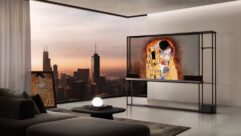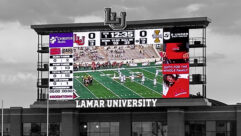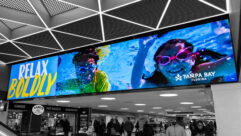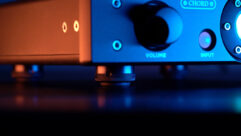
Art + Tech
Apr 16, 2012 11:30 AM, By Cynthia Wisehart
I’m sitting in the Kodak Theatre on Hollywood Boulevard in the wee hours of the morning—while Meyer Sound’s Steve Ellison and Pierre Germain finish commissioning a Constellation acoustic system in preparation for handing it over to the creatives.
Over my head—throughout the tiered theater—46 new wired microphones stand ready to pick up the sounds of 2,500 spectators. At the moment, we are an audience of seven: Ellison and Germain, the show’s sound designers Francois Bergeron and Vikram Kirby from Thinkwell (they also designed all the sound systems); Thinkwell project manager Patrick Janssen; and the Iris head of audio Sylvain Brisebois. The team is getting a new and necessary tool.
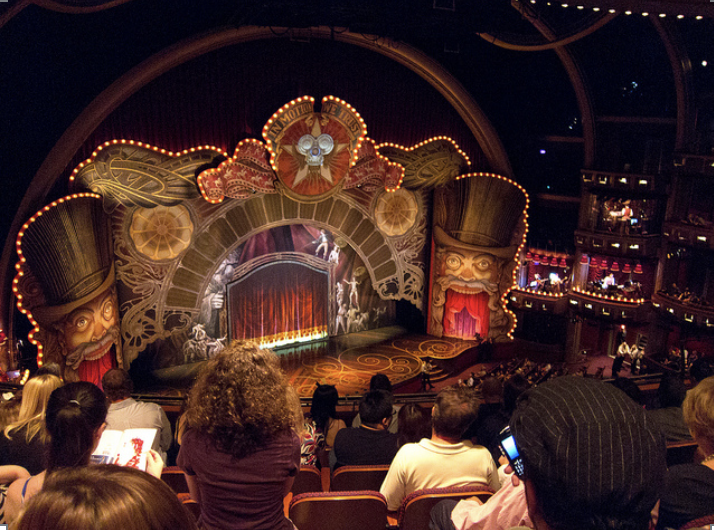 When the Kodak Theater opened in 2001 as the new home of the Academy Awards, Los Angeles Times music critic Mark Swed gave it a “tin ear for acoustics,” and bemoaned the perplexing and primitive sound of a room that is dead at most frequencies discernable to the human ear. Adequate perhaps for the Oscar telecast—in fact it sounds more like a soundstage than a theater. The applause reads as a polite smattering, no matter how enthusiastic; naturally that kind of decorum is anathema to the Cirque du Soleil experience where the audience wants to share every laugh and gasp. This room can take that energy away. Right now, tonight, the idea is to give it back.
When the Kodak Theater opened in 2001 as the new home of the Academy Awards, Los Angeles Times music critic Mark Swed gave it a “tin ear for acoustics,” and bemoaned the perplexing and primitive sound of a room that is dead at most frequencies discernable to the human ear. Adequate perhaps for the Oscar telecast—in fact it sounds more like a soundstage than a theater. The applause reads as a polite smattering, no matter how enthusiastic; naturally that kind of decorum is anathema to the Cirque du Soleil experience where the audience wants to share every laugh and gasp. This room can take that energy away. Right now, tonight, the idea is to give it back.
In fact, explains Steve Ellison, Cirque has been using Constellation’s underlying technology to enhance audience engagement for more than a decade, first on O at Bellagio when producers wanted to give the clowns more feedback and better connect the audience to the shared space. Instead of altering the space physically—with all the cost, permanence, and unintended consequences—Meyer has helped Cirque deploy a system with underlying technology developed by Dr. Mark Poletti called Variable Room Acoustics System (VRAS); most of the team I’m sitting with has used it on multiple shows. They still call it “V-ras,” occasionally commenting over Ellison’s shoulder on some user-friendly detail in the formalized Constellation GUI, which they are using for the first time right now.
Constellation is essentially a flexible electronic acoustical treatment. In simplest terms, the room is miked, processed, and played back to itself. For Iris, the processed signals are matrixed through 96 dedicated Meyer Sound loudspeakers supplied by audio provider Solotech, including the CQ-1, UP-4XP, MM-4XP, and MM-4XPD as well as rings of UPA-1Ps that are used for surrounds. Many times, the purpose of a Constellation installation is simply to offset aspects of a room that are not ideal—make the room bigger, more or less absorbent, or more or less reverberant. It can be used for multipurpose venues to adapt the room acoustics to different types of events or even room sizes. But the Cirque designers have something more in mind—something much more dynamic.
They talk among themselves, speculating about what they will do when they get their hands on the system. Sound designer Bergeron and associate designer Kirby had already done what they could with systems design and mixing to enliven the arid theater. Some of that processing can now be abandoned; now they can leverage the new acoustics and tune the room song by song, even cue by cue. Kirby says the show mix will change, not just technically but artistically in response to this new acoustical palette that opens up as another voice in the mix. They compare notes on previous VRAS deployments and toss around some ideas, Kirby and Brisebois are sure that composer Danny Elfman will want to do even more with dynamically moving the orchestra voices to track the sweep of the performers, creating an “enveloping” quality that Brisebois says is the driving goal of the score. But, Kirby adds, “We’ll need to damp the VRAS on some of the numbers or we’ll muddy the mix.”
Beyond the mix and the presets, Brisebois will also now have a Constellation fader in his compact mixing position (row R, house right) where he will vary the room’s absorption in real time, reading the audience’s mood and giving them and the performers a feedback loop to tap into and play off of. So, he says, if the audience is a little mellow on a Sunday matinee, they can be coaxed to life by turning up the gain on the Constellation system, magnifying their reactions to the show.
While Ellison and Germain work to establish and measure the acoustic baseline, we’re getting a good response demo from the cleaner on the first mezzanine. Constellation system off: The sound of the mop in the bucket is shallow and dry, and localized just over my right shoulder. System on: The bucket is a little bigger, a little farther away, a little warmer, and more resonant. The difference is unmistakable and a little eerie to hear. It was like being in a postproduction suite A/Bing sweetening options—except it was happening live in real life, in a theater that was literally toggling on and off on command, from a 1.3-second reverb to about 2 seconds. It’s not hard to extrapolate what that will do to the energy of 2,500 spectators.
Commissioning is tedious work and I’m just the press. I scan the theater and my mind wanders to what ops director Kevin Kiley had told me a few days before: Every year, Cirque has to move out for Oscar week. So, although Iris is essentially a permanent show, the elaborate AV systems are designed to be completely portable. Backstage, it looks like a touring show, with collections of racks huddled into various clusters and workspaces. The banks of Meyer D-mitri processors (and now Constellation processors) are ganged in big horizontal flight case-style racks that seem to have been dropped haphazardly in a hallway. (There is nothing haphazard about the system design; but that’s a story for another time. I have seen hundreds of sound systems including in world-class theme parks and museums, and this is one of the most creative designs I’ve ever seen). Kiley estimates the strike took six days—it all has to go, all the audio systems, projection and capture systems, lighting, rigging, automation, lifts, plus a vast unidentified collection of stuff that the performers accumulate. Putting it all back? That takes twice as long. It seems like it should take longer, since Kiley’s team is not just recommissioning AV systems; they are making rigging systems safe for human life, and dealing with a 40ft.-deep basement packed with lifts and automation.
 While the sound guys work, head of projection Tom Juliano grabs a seat and we scratch the surface of the projection technique behind the Iris visual storytelling. As a history of cinema, the show is both about projection and integrated with it. Many of the illusions are based on an ingenious system of IR tracking—it’s something like a motion-capture system. The 20 Christie projectors are basically just light machines—the story is in the software—which comes via Montreal-based Vyv and its Photon media server. To oversimplify greatly, the show is making its own footage in realtime—live cameras track and capture the performers, play the footage back from cached memory (like the way slow-mo replay works) with delays and other aesthetic processing. The performers, in turn, interact with the projected images that they have just made, like movie actors hitting their marks, while doing precision acrobatics and pratfalls.
While the sound guys work, head of projection Tom Juliano grabs a seat and we scratch the surface of the projection technique behind the Iris visual storytelling. As a history of cinema, the show is both about projection and integrated with it. Many of the illusions are based on an ingenious system of IR tracking—it’s something like a motion-capture system. The 20 Christie projectors are basically just light machines—the story is in the software—which comes via Montreal-based Vyv and its Photon media server. To oversimplify greatly, the show is making its own footage in realtime—live cameras track and capture the performers, play the footage back from cached memory (like the way slow-mo replay works) with delays and other aesthetic processing. The performers, in turn, interact with the projected images that they have just made, like movie actors hitting their marks, while doing precision acrobatics and pratfalls.
And just as Brisebois will mix aspects of the acoustics in realtime, the video operator mixes aspects of the projector focus live. Here’s why: The huge screens that fly in throughout the show are not what you would imagine—they’re not on rigid frames, they are giant sails, rippling stage left to stage right and being sucked upstage and down stage on the Z axis (“They were here when I got here,” Juliano sighs). So: As part of the software processing system, a tech can sit on a little Behringer MIDI box watching the show, turning pots, and tuning the projector focus on all three axes.
Meanwhile, back in the seats with the Constellation crew it’s getting really late. The cleaner has left, and Cirque violinist Sandy Cameron slips down a side aisle headed for the exit. She stayed late to practice and she thinks she’s done for the night. Instead, her colleagues rope her into the commissioning process. She helpfully stands center stage, a small figure in an enormous proscenium box full of rigging and worklights. She lifts her priceless violin, on loan from the Stradivari Society and starts riffing. She’s warmed up and sounds amazing. As she plays, Germain and Ellison patrol the four acoustic zones, listening for consistent response. They had brought their own anechoic recordings, of course, but this live and beautiful music is a much sweeter test and measurement. It makes me wish the L.A. Times critic was here right now, to give the room a second chance.
What is Constellation?
Constellation employs at its core the patented VRAS algorithm invented by Dr. Mark Poletti. His motivation in developing VRAS was communication, what he described as the four communications of live performance. In a live performance there is a two-way communication between the performers and the audience and feedback from the room to both performers and the audience,” Poletti writes. If any one of those four exchanges is weak, the total experience suffers.
Meyer Sound’s Constellation system employs advanced digital processing and miniature transducer technology to enable a scaling of room absorption and reverb without artifacts. The system can be comprised of a variety of wired microphones and self-powered speakers (as well as integrated into show system loudspeakers). The idea is to create optimal but flexible acoustics for buildings that have a variety of acoustic and aesthetic needs, or which may be used for different purposes that require varied acoustics.
Once Constellation is installed in the venue and tuned, a simple press of a button will instantly change the room’s acoustical properties.
Shape-shifting Logomo Hall
Logomo Hall in Turku, Finland, uses a Meyer Sound Constellation system to assume whatever size or shape is suited for the event of the evening. On one night it can provide a compact 1,100-seat space with a nearly square audience area. Within a few hours, it can be an elongated rectangle accommodating 3,500. A permanently installed Constellation acoustic system instantly optimizes acoustical response for both the current room configuration and the event.
Logomo Hall is the centerpiece of a refurbished industrial complex that was originally built for railway maintenance. Since the hall shares its space with a prefunction lobby, the physical versatility is made possible by a massive seating stand that glides back and forth on compressed air cushions. One space shrinks while the other enlarges to form three hall sizes, while the stage also offers three configurations.
The Constellation system employs 76 microphones to pick up ambient acoustical energy, which is returned to the room as early reflections and late reverberations through 223 discreet, self-powered loudspeakers and 12 compact subwoofers. Constellation is equipped with presets for nine hall/stage configurations, each with acoustical environments as defined by reverberation time, early decay time, strength, clarity, and bass ratio (warmth).


